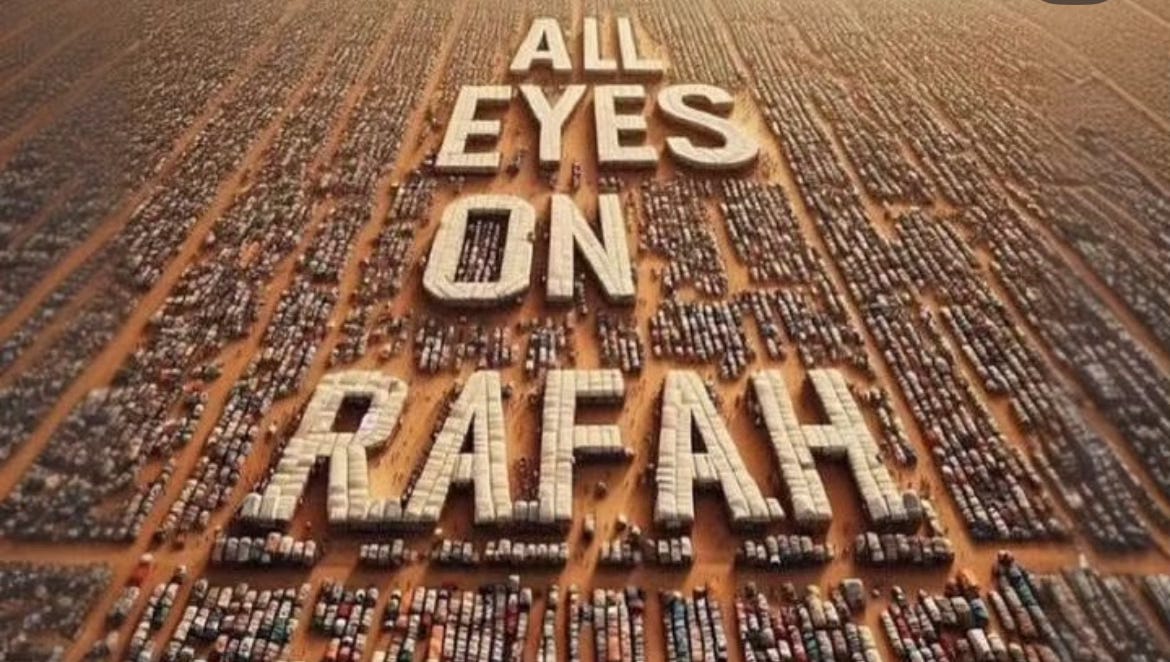Genocide & Geraniums
Instagram is Ground Zero of cognitive dissonance, a place that proudly showcases the banal brutality—and beauty—of this world and this country
No generation before us has witnessed a live streamed genocide. And certainly no generation before us has witnessed a live streamed genocide while shopping for hand-tufted woollen rugs, rolling eyes at yet another influencer’s ‘hidden gem’ and grooving to a little girl dancing to Jerusalema while practising the ‘greatest core exercise you’ve never heard of’.
Of all the social media I’m on, Instagram is peak cognitive dissonance. Ground Zero, as they say.
Para athletes, mirrors that glide across hidden shelves, a bombed out homeland, plush houses for sale, sex toys, explainers about casteist slurs and why you shouldn’t tuck in your oversize t-shirts, dead bodies, protein powder, Noida sub-cultures, everyday atrocities and old ladies who have found a new medium to speak up, all appear in one continuous, stream of consciousness experience.
And underlying it all, the banal brutality of this world and this country.
Cut fingers, smashed heads and other assorted assaults and humiliations must jostle their way through birthday updates, gorgeous balcony gardens, impeccably plated meals and personal announcements like the one I made recently: ‘My sporty niece has got me a ticket to the hottest party in Mumbai this weekend: the WPL finals.’
Here, horror and crimes compete with India’s most photographed neighbourhoods. Don’t forget, people actually go places and try new things just so they can post about it on Instagram.
Wait, they want to do what? Cover the mosques in UP’s Sambal with tarpaulin during Holi and build a toilet over Aurangzeb’s grave? And that reel about India’s just-launched sunken museum—dedicated to Humayun no less—was nice but why did the person use the music of a film on Akbar? Shut up Instagram. Nobody—no matter how crazy and hateful—can erase the legacy of India’s Mughals.
X is predictably toxic, Facebook is persona non grata, Blue Sky is a cozy throw with an attached all-are-welcome bookclub and LinkedIn is mostly artifice and posturing. But Instagram, thanks to its swipe-y audiovisual + text format, is something else.
It provides a pithy five-slide explanation for everything from Sudan to suicidal ideation. Once you’ve shared it, liked it and maybe read it, it’s time to skip to the next thing. Joy, grief, silliness, pomposity, extravagance, brutality, wisdom, stupidity, lies, hard truths, insights, ignorance all line up in a formation that would be impossible to replicate on any sporting field.
They call it the algorithm and everyone’s is slightly different. Its goal? To make you (40% of the world is here) spend as much time on it as possible, dunking you repeatedly in the morass of mixed messaging, fooling you into believing you are a Parle G who just got a chance to attain nirvana in a cuppa chai.
In one study, 26.5% of participants showed signs of mild addiction, 6.1% were moderately addicted, and almost 1% were severely addicted. Some 33.5% were at high risk for addiction. It’s mostly impossible to not get addicted to this kaleidoscope as you bounce off its reflective surfaces, believing that you are creating your own patterns.
My celebrity algorithm is equal parts toxic men (autocrats, billionaires, Islamophobes, former Supreme Court robers) and inspirational women. In March, Roberta Flack, Jane Fonda, Zeenat Aman, Ali Wong and Bhanwari Devi jostled for my attention.
Our kids are on Instagram too, leading completely separate lives behind do not disturb doors. We can only hope that their feeds are bursting with puppy videos, study smarter tips, music concert alerts and other assorted celebrity news about people we may not even have heard about. We know little to nothing about how they tackle predators/bullies and how they’re impacted by all those glass skin videos.
We are all drawn to different parts of this psychedelic monster and no one experience mirrors the other. Dirty Instagram secret: I rarely watch the reels my friends and family send me, and these are people who know my likes and dislikes intimately.
Once in a while, a tragedy with the requisite vim and virality, unites 10% of us. It helps if there are words we can all get behind. The AI image of tents with the words ‘All Eyes on Rafah’ after an Israeli airstrike in Gaza in 2024, for example, was shared by 47 million people. To give you some perspective, Instagram has around 500 million daily active users; most are Gen Z and Millennials.
And that’s the other thing. We call them users. Users who may pause to lend their attention to Rafah for a few seconds, minutes, or days before they dive back into the bog (or Borg if you are a Trekkie), slowly assimilating into the algorithm.





This hit so hard. This reality truly seems unreal.
One day, years ago, I opened an Instagram account. I stayed there for a week and then got out. Made me feel like Picard.